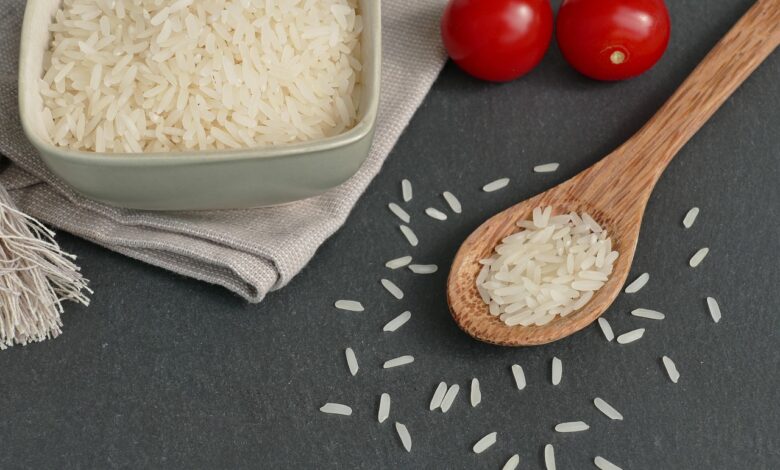Extra Long Grain Basmati Rice – Perfect for Fluffy Biryanis

In the diverse world of rice, few varieties command the global attention and admiration that extra long grain basmati rice does. Known for its majestic length, delightful aroma, and non-sticky texture, this premium rice variety is more than just a cooking ingredient—it’s a culinary experience.
Often associated with regal feasts, celebratory meals, and international fine dining, extra long grain basmati rice has earned its place as a staple in homes and restaurants across the globe. From biryanis to pilafs, its superior attributes make it the top choice for chefs and rice connoisseurs alike.
What is Extra Long Grain Basmati Rice?
Extra long grain basmati rice is a special grade of traditional Basmati rice, characterized by its superior grain length (often 8.4mm and longer), delicate texture, and enchanting aroma. Cultivated primarily in the fertile foothills of the Himalayas in India and Pakistan, this rice is a symbol of the region’s rich agricultural heritage.
Once cooked, the grains of this rice can elongate up to twice their original length while retaining a firm, non-sticky structure. The result is a fluffy, aromatic rice that enhances the appeal and taste of any dish it accompanies.
Key Features That Set It Apart
1. Exceptional Grain Length:
Extra long grain basmati rice is visually impressive. Its uncooked grains are among the longest in the world and can reach over 8.4mm in length. After cooking, these grains expand significantly without becoming mushy.
2. Aromatic Appeal:
One of the hallmarks of basmati rice is its signature nutty fragrance, thanks to the compound 2-acetyl-1-pyrroline (2-AP). This aroma intensifies during the cooking process, filling the kitchen with a rich, appetizing scent.
3. Fluffy, Non-Sticky Texture:
Despite its long grains, extra long grain basmati rice retains a light and fluffy texture. Each grain remains separate when cooked, making it ideal for elaborate rice dishes like biryani and pulao.
4. Low Glycemic Index:
It offers a lower glycemic index compared to other white rice varieties, making it a more diabetic-friendly option when consumed in moderation.
5. Naturally Gluten-Free:
This rice is naturally gluten-free, making it suitable for people with celiac disease or gluten sensitivity.
Culinary Applications Around the World
The versatility of extra long grain basmati rice has made it a favorite in both traditional and contemporary cuisines worldwide:
- Biryani:
Whether it’s Hyderabadi, Lucknowi, or Kolkata-style, biryani demands rice that can withstand the layering of spices and meat. Extra long grain basmati rice not only holds up but elevates the dish with its aroma and texture. - Pulao and Fried Rice:
Its ability to absorb flavors while staying separate makes it a great choice for spiced pulao or even Asian-style fried rice. - Middle Eastern Dishes (Kabsa, Mandi):
Popular across Gulf countries, these rice dishes rely on basmati rice’s fragrance and length to create an aesthetically pleasing and flavorful meal. - Plain Steamed Rice:
Even served on its own, the fluffiness and aroma of this rice turn a simple bowl of rice into something special.
Benefits for Exporters, Importers, and Food Service Businesses
Extra long grain basmati rice isn’t just a consumer favorite—it’s also a smart business choice for wholesalers, distributors, and exporters.
1. High Demand Worldwide:
The Middle East, North America, Europe, and Southeast Asia continue to see growing demand for premium rice varieties, especially extra long grain basmati rice.
2. Better Yield Per Serving:
Because of its elongation and fluffiness after cooking, a smaller quantity of rice can serve more people, offering great value in commercial kitchens.
3. Longer Shelf Life:
Aged basmati rice—especially varieties aged for 12 to 24 months—offers enhanced flavor and longevity, reducing waste and increasing customer satisfaction.
4. Private Labeling Opportunities:
Many manufacturers offer white-label or customized packaging for international retailers, allowing them to market premium rice under their own brand name.
Packaging and Storage
To retain its aroma and freshness, extra long grain basmati rice is packaged using food-grade materials like:
- Vacuum-sealed pouches
- Non-woven PP bags
- Jute bags with laminated liners
Proper storage recommendations include:
- Keep the rice in a cool, dry place
- Use airtight containers after opening
- Avoid storing near strong-smelling foods to prevent absorption of odors
Choosing the Right Brand or Supplier
When selecting extra long grain basmati rice, look for the following indicators of quality:
- Grain Length Clearly Mentioned (≥8.4mm)
- Origin of Cultivation (India or Pakistan)
- Age of Rice (Minimum 12 months aging is ideal)
- Certifications (ISO, HACCP, Halal, Non-GMO)
- Trusted Brand Name or Exporter
Reputable suppliers often conduct multiple quality checks at every stage—from paddy selection and milling to final packaging—to ensure that the product meets international standards.
Final Thoughts
Extra long grain basmati rice is not just a culinary ingredient—it is a mark of tradition, quality, and gastronomic excellence. Whether you’re a home cook crafting the perfect biryani or a food business looking for premium ingredients, this rice variety promises satisfaction in every grain.
With its unique blend of elegance, nutrition, and flavor, extra long grain basmati rice continues to be a top choice in kitchens around the world, delivering not just meals, but memorable dining experiences.


